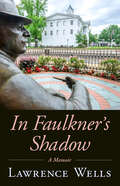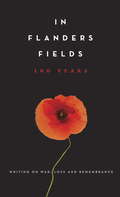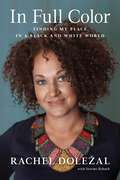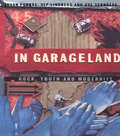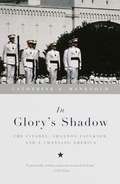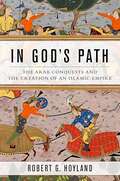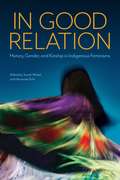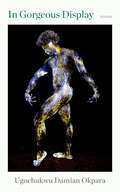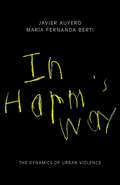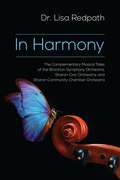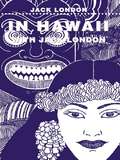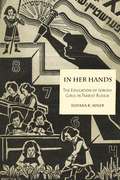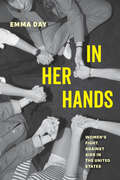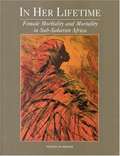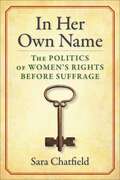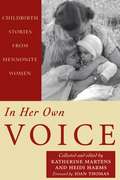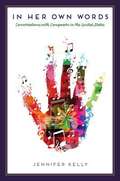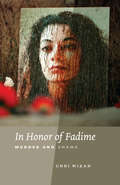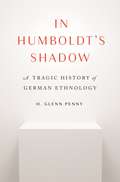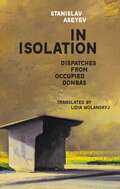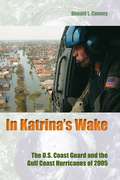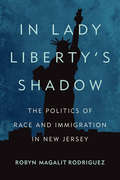- Table View
- List View
In Faulkner's Shadow: A Memoir (Willie Morris Books in Memoir and Biography)
by Lawrence WellsWhat happens when you marry into a family that includes a Nobel Prize winner who is arguably the finest American writer of the twentieth century? Lawrence Wells, author of In Faulkner’s Shadow: A Memoir, fills this lively tale with stories that answer just that. In 1972, Wells married Dean Faulkner, the only niece of William Faulkner, and slowly found himself lost in the Faulkner mystique. While attempting to rebel against the overwhelming influence of his in-laws, Wells had a front-row seat to the various rivalries that sprouted between his wife and the members of her family, each of whom dealt in different ways with the challenges and expectations of carrying on a literary tradition. Beyond the family stories, Wells recounts the blossoming of a literary renaissance in Oxford, Mississippi, after William Faulkner’s death. Both the town of Oxford and the larger literary world were at a loss as to who would be Faulkner’s successor. During these uncertain times, Wells and his wife established Yoknapatawpha Press and the quarterly literary journal the Faulkner Newsletter and Yoknapatawpha Review. In his dual role as publisher and author, Wells encountered and befriended Larry Brown, Barry Hannah, Willie Morris, and many other writers. He became both participant and observer to the deeds and misdeeds of a rowdy collection of talented authors living in Faulkner’s shadow. Full of personal insights, this memoir features unforgettable characters and exciting behind-the-scene moments that reveal much about modern American letters and the southern literary tradition. It is also a love story about a courtship and marriage, and an ode to Dean Faulkner Wells and her family.
In Fitting Memory: The Art and Politics of Holocaust Memorials
by Sybil Milton Ira NowinskiIn Fitting Memory, a critical survey of Holocaust memorials and monuments in Europe, Israel, and the United States, focuses on the archeological remains at the original sites of Nazi terror which constituted the first postwar memorials. The Holocaust is defined here as the collective designation for the Nazi mass murder of Jews, Gypsies, and the handicapped, and for the related persecution of Soviet prisoners of war and other ideological opponents. Featuring text and photographs, the book shows how, since 1945, memorials and monuments have served not only as secular shrines, but also as temporal institutions reflecting changing public constituencies and distinctive political, social, and cultural contexts. Sybil Milton poses two vital and provocative questions about the memorials built since the end of World War II: to whose memory were they built and how fitting are they? <P><P> The Holocaust is a sensitive subject whose representation demands accuracy and tact. This volume, the first study of the institutionalization of public memory, demonstrates how various nations, politicians, and designers have attempted to do justice to this subject in public art and sculpture, and shows how national origin, ethnic allegiance, political ideology, and prevailing artistic style determined how memorials were commissioned and installed. This book also provides an analysis of the complex interrelationship between authentic historic sites, disparate and ephemeral representations of history, and the changing political and aesthetic balance between commemoration and escapism. <P><P> In Fitting Memory includes 127 specially commissioned photographs by Ira Nowinski from seven European countries, the United States, and Israel. Nine additional photographs are by photographers from Italy, the Netherlands, and the United States. The riveting images provide the reader with a visual tour of these memorials. Along with an annotated bibliography, the volume also contains a comprehensive list of memorials in Europe, the United States, and Israel. An essential tool for those interested in visiting the memorial sites, the book also provides a critical analysis for serious researchers. <P><P> Sybil Milton is the Resident Historian at the United States Holocaust Memorial Council in Washington, D.C. She is coauthor of Art of the Holocaust, the definitive work on the subject and the winner of the National Jewish Book Award in Visual Arts in 1981. She is also the editor of The Art of Jewish Children, Germany: 1936-1941; Innocence and Persecution. Sybil Milton earned her Ph.D. from Stanford University. <P><P> Ira Nowinski, an independent photographer, is a graduate of the San Francisco Art Institute and a recipient of three grants from the National Endowment for the Arts. His work is represented in many permanent collections, including the Museum of Modern Art, the Library of Congress, Yad Vashem, and the Judah L. Magnes Museum. His books include Cafe Society: Photographs and Poetry from San Francisco's North Beach; No Vacancy: Urban Renewal and the Elderly; and Grandissimo Pavarotti.
In Flanders Fields: 100 Years
by Amanda BettsA beautifully designed collection of essays on war, loss and remembrance to commemorate the 100th anniversary of the writing of Canada's most famous poem. In early 1915, the death of a young friend on the battlefields of Ypres inspired Canadian soldier, field surgeon and poet John McCrae to write "In Flanders Fields." Within months of the poem's December 1915 publication in the British magazine Punch it became part of the collective consciousness in North America and Europe, and its extraordinary power has endured over the decades and across generations. In this anthology, Canada's finest historians, novelists and poets contemplate the evolving meaning of the poem; the man who wrote it and the World War I setting from which it emerged; its themes of valour, grief and remembrance; and the iconic image of the poppy. Among the thirteen contributors: Lieutenant-General Roméo Dallaire (ret'd) writes about the emotional meaning of the poem for war veterans; Tim Cook describes the rich and varied life of McCrae; Frances Itani revisits her time in Flanders, and mines the acts of witnessing and remembering; Kevin Patterson offers a riveting depiction of the adrenaline-fueled work of a WWI field surgeon; Mary Janigan reveals the poem's surprisingly divisive effect during the 1917 federal election; Ken Dryden tells us how lines from the poem ended up on the wall of the Montreal Canadiens' dressing room; and Patrick Lane recalls a Remembrance Day from his childhood in a moving reflection on how war shapes us all. Gorgeously designed in full colour with archival and contemporary images, In Flanders Fields: 100 Years will reflect and illuminate the importance of art in how we process war and loss.
In Full Color: Finding My Place in a Black and White World
by Rachel Dolezal Storms RebackA lot of people have made up their minds about Rachel Doležal. But none of them know her real story. In June 2015, the media "outed" Rachel Doležal as a white woman who had knowingly been "passing" as Black. When asked if she were African American during an interview about the hate crimes directed at her and her family, she hesitated before ending the interview and walking away. Some interpreted her reluctance to respond and hasty departure as dishonesty, while others assumed she lacked a reasonable explanation for the almost unprecedented way she identified herself. What determines your race? Is it your DNA? The community in which you were raised? The way others see you or the way you see yourself? With In Full Color, Rachel Doležal describes the path that led her from being a child of white evangelical parents to an NAACP chapter president and respected educator and activist who identifies as Black. Along the way, she recounts the deep emotional bond she formed with her four adopted Black siblings, the sense of belonging she felt while living in Black communities in Jackson, Mississippi, and Washington, DC, and the experiences that have shaped her along the way. Her story is nuanced and complex, and in the process of telling it, she forces us to consider race in an entirely new light—not as a biological imperative, but as a function of the experiences we have, the culture we embrace, and, ultimately, the identity we choose.
In Garageland: Rock, Youth and Modernity (Communication and Society)
by Johan Fornäs Ulf Lindberg Ove SernhedeSeeking to understand youth culture through its visual and musical expression, In Garageland presents a pioneering ethnographic study of rock bands and their fans. Topics include class as well as sexual conflicts; mainstream and deviant subcultures, and the complex social, psychological and ethical relationships which exist within youth culture. In Garageland develops the notion of youth culture research as a way of mirroring our grown-up identities and of staking out the limits of late modern culture in general.
In Glory's Shadow: The Citadel, Shannon Faulkner, and a Changing America
by Catherine S. ManegoldIn Glory's Shadow explores the history of The Citadel, an institution set on preserving tradition in the face of profound change. Established as protection against slave insurrections feared by the white minority of Charleston, South Carolina, a generation later The Citadel was a school of privilege for young white men. Through two world wars it grew in size and reputation, proudly providing the United States with (male) military leaders, paying little heed to what was happening in the country around it.In 1993, when the school rescinded Shannon Faulkner's admission because of her gender, a landmark legal battle ensued. Faulkner won, and although she faced vicious harassment and left after a week, The Citadel was forced to reform: nearly 30 women have graduated since her brief time at The Citadel. In Glory's Shadow is an engrossing and illuminating look at this pivotal event in military history and the history of women.From the Trade Paperback edition.nmark Vesey slave revolt, called for a citadel and hastily organized a private militia. Twenty years later that small home guard was remade into a school where white youths might gain access to a world of elegance, wealth and power. We see the school grow in size and reputation through two world wars until the last few decades, when, as America wrestled with chaotic calls to power from blacks, women, immigrants and homosexuals, The Citadel took the path the country as a whole was rejecting and proudly marched in place. The cadets clung to antique hierarchies born of slavery and war, employing careful courtesies in public while practicing archaic and often brutal rituals within their barracks.This is the world Shannon challenged. When she arrived at The Citadel's gates and was turned away because of her sex, the stage was set for conflict. We watch her struggle to a triumph that was short-lived: She won her case but left The Citadel after a single week -- three years at the center of the storm, and fear for her family's safety, finally wore her down. Manegold illuminates the course -- historical, judicial and psychological -- of Shannon's fight and uncovers a striking American drama, a clash between those who would preserve the rigid structures of the past and those trying to chart a new course in a nation remaking itself.From the Hardcover edition.
In God's Path: The Arab Conquests And The Creation Of An Islamic Empire
by Robert G. HoylandIn just over a hundred years - from the death of Muhammad in 632 to the beginning of the Abbasid Caliphate in 750 - the followers of the Prophet swept across the whole of the Middle East, North Africa, and Spain. Their armies threatened states as far flung as the Franks in Western Europe and the Tang Empire in China. The conquered territory was larger than the Roman Empire at its greatest expansion, and it was claimed for the Arabs in roughly half the time. How this collection of Arabian tribes was able to engulf so many empires, states, and armies in such a short period has perplexed historians for centuries. Most accounts of the Arab invasions have been based almost solely on the early Muslim sources, which were composed centuries later to illustrate the divinely chosen status of the Arabs. Robert Hoyland's groundbreaking new history assimilates not only the rich biographical information of the early Muslim sources but also the many non-Arabic sources, contemporaneous or near-contemporaneous with the conquests. In God's Path begins with a broad picture of the Late Antique world prior to the Prophet's arrival, a world dominated by two superpowers: Byzantium and Sasanian Persia. In between these empires, emerged a distinct Arabian identity, which helped forge the inhabitants of western Arabia into a formidable fighting force. The Arabs are the principal actors in this drama yet, as Hoyland shows, the peoples along the edges of Byzantium and Persia - the Khazars, Bulgars, Avars, and Turks - all played critical roles in the remaking of the old world order. The new faith propagated by Muhammad and his successors made it possible for many of the conquered peoples to join the Arabs in creating the first Islamic Empire. Well-paced, comprehensive, and eminently readable, In God's Path presents a sweeping narrative of a transformational period in world history.
In Good Relation: History, Gender, and Kinship in Indigenous Feminisms
by Sarah Nickel Amanda FehrOver the past thirty years, a strong canon of Indigenous feminist literature has addressed how Indigenous women are uniquely and dually affected by colonialism and patriarchy. Indigenous women have long recognized that their intersectional realities were not represented in mainstream feminism, which was principally white, middle-class, and often ignored realities of colonialism. As Indigenous feminist ideals grew, Indigenous women became increasingly multi-vocal, with multiple and oppositional understandings of what constituted Indigenous feminism and whether or not it was a useful concept. Emerging from these dialogues are conversations from a new generation of scholars, activists, artists, and storytellers who accept the usefulness of Indigenous feminism and seek to broaden the concept. In Good Relation captures this transition and makes sense of Indigenous feminist voices that are not necessarily represented in existing scholarship. There is a need to further Indigenize our understandings of feminism and to take the scholarship beyond a focus on motherhood, life history, or legal status (in Canada) to consider the connections between Indigenous feminisms, Indigenous philosophies, the environment, kinship, violence, and Indigenous Queer Studies. Organized around the notion of “generations,” this collection brings into conversation new voices of Indigenous feminist theory, knowledge, and experience. Taking a broad and critical interpretation of Indigenous feminism, it depicts how an emerging generation of artists, activists, and scholars are envisioning and invigorating the strength and power of Indigenous women.
In Gorgeous Display
by Ugochukwu Damian OkparaOne of Book Riot's Must-Have New Poetry for Fall 2023 The remarkable debut collection by a young Nigerian queer poet.“here / i am not his image / & i envy it / i shut my eyes against what is left / the crackling softness of life / like communion / desire is a marathon / a baton waiting for your grip / here / i am not running / neither is he / i sit with a man for the first time / & we talk about war . . .”—FROM “BEAUTIFUL BOY WITH GARLANDS AROUND HIS WAIST”In Gorgeous Display, by Nigerian poet Ugochukwu Damian Okpara, is a volume dedicated to the memory of those lost to anti-queer violence in Nigeria and elsewhere. In this first full-length collection of his work, Okpara examines queer male identity, effeminacy, and exile, offering meditations on desire and sanctuary, freedom and estrangement. Forty-three poems pierce familial relationships, safety, fear, and anxiety portrayed through the outward sign of hand tremors, queer lynching, survival, hope, the emptiness of exile, and reclamation of the self. Embracing the ephemeral and spiritual nature of physical beauty, Okpara also reveals the scars of queer displacement, illuminating the ways that leaving home is never quite the utopia one hopes for and how often the ache of abandonment can haunt a life lived in the present.
In Harm's Way
by Javier Auyero María Fernanda BertiArquitecto Tucci, a neighborhood in Buenos Aires, is a place where crushing poverty and violent crime are everyday realities. Homicides--often involving young people--continue to skyrocket, and in the emergency room there, victims of shootings or knifings are an all-too-common sight. In Harm's Way takes a harrowing look at daily life in Arquitecto Tucci, examining the sources, uses, and forms of interpersonal violence among the urban poor at the very margins of Argentine society.Drawing on more than two years of immersive fieldwork, sociologist Javier Auyero and María Berti, an elementary school teacher in the neighborhood, provide a powerful and disarmingly intimate account of what it is like to live under the constant threat of violence. They argue that being physically aggressive becomes a habitual way of acting in poor and marginalized communities, and that violence is routine and carries across various domains of public and private life. Auyero and Berti trace how different types of violence--be it criminal, drug related, sexual, or domestic--overlap, intersect, and blur together. They show how the state is complicit in the production of harm, and describe the routines and relationships that residents, particularly children, establish to cope with and respond to the constant risk that besieges them and their loved ones.Provocative, eye-opening, and extraordinarily moving, In Harm's Way is destined to become a classic work on violence at the urban margins.
In Harmony: The Complementary Musical Tales of the Brockton Symphony Orchestra, Sharon Civic Orchestra, and Sharon Community Chamber Orchestra
by Dr. Lisa M. RedpathIn Harmony: The Complementary Musical Tales of the Brockton Symphony Orchestra, Sharon Civic Orchestra, and Sharon Community Chamber Orchestra is a stirring, historical account of these three Massachusetts ensembles. Each chapter documents the orch
In Hawaii
by LondonPublished in the year 2001, In Hawaii is a valuable contribution to the field of Social Science.
In Her Hands: The Education of Jewish Girls in Tsarist Russia
by Eliyana R. AdlerThough over one hundred private schools for Jewish girls thrived in the areas of Jewish settlement in the Russian empire between 1831 and 1881, their story has been largely overlooked in the scholarship of Jewish educational history. In Her Hands: The Education of Girls in Tsarist Russia restores these schools to their rightful place of prominence in training thousands of Jewish girls in secular and Judaic subjects and also paving the way for the modern schools that followed them. Through extensive archival research, author Eliyana R. Adler examines the schools' curriculum, teachers, financing, students, and educational innovation and demonstrates how each of these aspects evolved over time. The first section of this volume follows the emergence and development of the new private schools for Jewish girls in the mid-1800s, beginning with the historical circumstances that enabled their creation, and detailing the staffing, financing, and academics in the schools. Adler dispels the myth that all education in Russia was reserved for boys by showing that a dedicated group of educators and administrators worked to provide new opportunities for a diverse group of Jewish girls. In the second section, Adler looks at the interactions between these new educational institutions and their communities, including how the schools responded to changes taking place around them and how they in turn influenced their environment. Adler consults several major archives, including those of the former Russian Ministry of Education, along with contemporary periodicals, educational materials, and personal memoirs to provide a remarkably complete picture of education for Jewish girls in Russia in the mid- to late nineteenth century. In telling the story of Russia's private schools for Jewish girls, Adler argues that these schools were crucibles of educational experimentation that merit serious examination. Scholars of Jewish history, educational history, and womens' studies will enjoy this pathbreaking study.
In Her Hands: Women's Fight against AIDS in the United States
by Dr. Emma DayIn Her Hands examines the various strategies women have utilized to fight for recognition as individuals vulnerable to and living with HIV/AIDS across multiple settings since the 1980s. Taking a new chronological and thematic approach to the study of the US epidemic, it explores five arenas of women’s AIDS activism: transmission and recognition, reproductive justice, safer sex campaigns for queer women, the carceral state, and HIV prevention and treatment. In so doing, it moves the historical understanding of women’s experiences of AIDS beyond their exclusion from the initial medical response and the role women played as the supporters of gay men. Asking how and on what terms women succeeded in securing state support, In Her Hands argues that women protesting the neglect of their health-care needs always risked encountering punitive intervention on behalf of the symbolic needs of fetuses and children – as well as wider society – deemed to need protecting from them.
In Her Lifetime: Female Morbidity and Mortality in Sub-Saharan Africa
by Committee to Study Female Morbidity Mortality in Sub-Saharan AfricaThe relative lack of information on determinants of disease, disability, and death at major stages of a woman's lifespan and the excess morbidity and premature mortality that this engenders has important adverse social and economic ramifications, not only for Sub-Saharan Africa, but also for other regions of the world as well. Women bear much of the weight of world production in both traditional and modern industries. In Sub-Saharan Africa, for example, women contribute approximately 60 to 80 percent of agricultural labor. Worldwide, it is estimated that women are the sole supporters in 18 to 30 percent of all families, and that their financial contribution in the remainder of families is substantial and often crucial.This book provides a solid documentary base that can be used to develop an agenda to guide research and health policy formulation on female health--both for Sub-Saharan Africa and for other regions of the developing world. This book could also help facilitate ongoing, collaboration between African researchers on women's health and their U.S. colleagues. Chapters cover such topics as demographics, nutritional status, obstetric morbidity and mortality, mental health problems, and sexually transmitted diseases, including HIV.
In Her Own Name: The Politics of Women’s Rights Before Suffrage
by Sara ChatfieldLong before American women had the right to vote, states dramatically transformed their status as economic citizens. In the early nineteenth century, a married woman had hardly any legal existence apart from her husband. By the twentieth, state-level statutes, constitutional provisions, and court rulings had granted married women a host of protections relating to ownership and control of property. Why did powerful men extend these rights during a period when women had so little political sway?In Her Own Name explores the origins and consequences of laws guaranteeing married women’s property rights, focusing on the people and institutions that shaped them. Sara Chatfield demonstrates that the motives of male elites included personal interests, benefits to the larger economy, and bolstering state power. She shows that married women’s property rights could serve varied political goals across regions and eras, from temperance to debt relief to settlement of the West. State legislatures, constitutional conventions, and courts expanded these rights incrementally, and laws spread across the country without national-level coordination.Chatfield emphasizes that the reform of married women’s economic rights rested on exclusionary foundations, including protecting slavery and encouraging settler colonialism. Although some women benefited from property reforms, many others saw their rights stripped away by the same processes. Drawing on a mix of qualitative and quantitative evidence, In Her Own Name sheds new light on the place of women in the fitful democratization of the United States.
In Her Own Voice: Childbirth Stories from Mennonite Women
by Katherine Martens Heidi HarmsWinnipeg writer Katherine Martens interviewed 26 women from the Mennonite community in southern Manitoba, ranging in age from 22 to 88 years old. They had many different backgrounds, but they all had one important characteristic: all were mothers.In the course of these interviews, Martens was searching for answers to questions that affected her both as a Mennonite and as a woman. How did they feel when they learned of the pregnancy? How did they choose home or hospital birth? How did the traditions of the Mennonite culture affect them as wives and mothers? As they talked, many spoke about the joys and trials of giving birth, and they also told Martens stories about other parts of their lives. Some had escaped the Russian Revolution to emigrate to Canada; others spent their entire lives in rural Manitoba, part of the close-knit Mennonite community, running farms and bearing as many as 15 children. Younger women who had formally left the Mennonite church were still conscious of the impact of the beliefs and customs on their lives.Many women were surprised to be approached for an interview, insisting that they had "no stories to tell." One was visited in a dream by her dead husband, who told her to "leave that alone." Yet, in the privacy of their kitchens and parlours, over sociable cups of tea, many did share with Martens their private fears and joys about what was often seen as a rite of passage into responsible adulthood, and they recalled that childbirth could be a difficult and, at times, traumatic event, but it could also be a radiant and spiritual experience.
In Her Own Words: Conversations with Composers in the United States
by Jennifer KellyThis collection of new interviews with twenty-five accomplished female composers substantially advances our knowledge of the work, experiences, compositional approaches, and musical intentions of a diverse group of creative individuals. With personal anecdotes and sometimes surprising intimacy and humor, these wide-ranging conversations represent the diversity of women composing music in the United States from the mid-twentieth century into the twenty-first. The composers work in a variety of genres including classical, jazz, multimedia, or collaborative forms for the stage, film, and video games. Their interviews illuminate questions about the status of women composers in America, the role of women in musical performance and education, the creative process and inspiration, the experiences and qualities that contemporary composers bring to their craft, and balancing creative and personal lives. Candidly sharing their experiences, advice, and views, these vibrant, thoughtful, and creative women open new perspectives on the prospects and possibilities of making music in a changing world.
In Hitler's Shadow: An Israeli's Amazing Journey Inside Germany's Neo-Nazi Movement
by Nick Taylor Yaron SvoraySvoray to be a sympathetic American and not realizing he was Jewish, introduced him to the semisecret world of German neo-Nazism. In a short time, Svoray contacted the Simon Wiesenthal Center in Los Angeles and, with the center's backing, returned to Germany under the name of "Ron Furey," the American representative of a fictitious right-wing organization. So began a remarkable and shocking series of encounters between Svoray and members of Germany's neo-Nazi underground. Putting himself at great personal risk and constantly fearing that his identity would be discovered, Svoray met-and documented with hidden cameras and recording devices-a terrifying array of believers both young and old whose reach, he was shocked to find out, extends throughout Germany and beyond. He came across brutal young skinheads; paramilitary training camps that have sent neo-Nazi fighters to support Croatian soldiers in the former Yugoslavia; a network of committed neo-Nazis who are using their money and connections to establish political organizations; and politicians of the far right who cloak their connections to the movement in nationalist rhetoric. In Hitler's Shadow is a sobering report on the real threat that is posed by Germany's neo-Nazi movement, and a startling portrayal of the dangerous personalities behind it, told by a man of immense courage who has penetrated its heart of darkness. YARON SVORAY has been a paratrooper in the Israeli Defense Force and a detective in Israel's Central Police Command, and is currently an investigative journalist. He lives in Israel. NICK TAYLOR is the author of four previous works of nonfiction: Bass Wars, Sins of the Father, Ordinary Miraclesand A Necessary End. He lives in New York.
In Honor of Fadime: Murder and Shame
by Unni WikanIn 2002 young Fadime Sahindal was brutally murdered by her own father. She belonged to a family of Kurdish immigrants who had lived in Sweden for almost two decades. But Fadime’s relationship with a man outside of their community had deeply dishonored her family, and only her death could remove the stain. This abhorrent crime shocked the world, and her name soon became a rallying cry in the struggle to combat so-called honor killings. Unni Wikan narrates Fadime’s heartbreaking story through her own eloquent words, along with the testimonies of her father, mother, and two sisters. What unfolds is a tale of courage and betrayal, loyalty and love, power and humiliation, and a nearly unfathomable clash of cultures. Despite enduring years of threats over her emancipated life, Fadime advocated compassion for her killer to the end, believing him to be trapped by an unyielding code of honor. Wikan puts this shocking event in context by analyzing similar honor killings throughout Europe, Canada, and the United States. She also examines the concept of honor in historical and cross-cultural depth, concluding that Islam itself is not to blame—indeed, honor killings occur across religious and ethnic traditions—but rather the way that many cultures have resolutely linked honor with violence. In Honor of Fadime holds profound and timely insights into conservative Kurdish culture, but ultimately the heart of this powerful book is Fadime’s courageous and tragic story—and Wikan’s telling of it is riveting.
In Humboldt's Shadow: A Tragic History of German Ethnology
by H. Glenn PennyA compelling history of the German ethnologists who were inspired by Prussian polymath and explorer Alexander von HumboldtThe Berlin Ethnological Museum is one of the world's largest and most important anthropological museums, housing more than a half million objects collected from around the globe. In Humboldt's Shadow tells the story of the German scientists and adventurers who, inspired by Alexander von Humboldt's inclusive vision of the world, traveled the earth in pursuit of a total history of humanity. It also details the fate of their museum, which they hoped would be a scientists' workshop, a place where a unitary history of humanity might emerge.H. Glenn Penny shows how these early German ethnologists assembled vast ethnographic collections to facilitate their study of the multiplicity of humanity, not to confirm emerging racist theories of human difference. He traces how Adolf Bastian filled the Berlin museum in an effort to preserve the records of human diversity, yet how he and his supporters were swept up by the imperialist currents of the day and struck a series of Faustian bargains to ensure the growth of their collections. Penny describes how influential administrators such as Wilhelm von Bode demanded that the museum be transformed into a hall for public displays, and how Humboldt's inspiring ideals were ultimately betrayed by politics and personal ambition.In Humboldt's Shadow calls on museums to embrace anew Bastian's vision while deepening their engagement with indigenous peoples concerning the provenance and stewardship of these collections.
In Isolation: Dispatches from Occupied Donbas (Harvard library of Ukrainian literature; #1)
by Stanislav AseyevIn this exceptional collection of dispatches from occupied Donbas, writer and journalist Stanislav Aseyev details the internal and external changes observed in the cities of Makiïvka and Donetsk in eastern Ukraine. Aseyev scrutinizes his immediate environment and questions himself in an attempt to understand the reasons behind the success of Russian propaganda among the working-class residents of the industrial region of Donbas. In this work of documentary prose, Aseyev focuses on the early period of the Russian-sponsored military aggression in Ukraine’s east, the period of 2015–2017. The author’s testimony ends with his arrest for publishing his dispatches and his subsequent imprisonment and torture in a modern-day concentration camp on the outskirts of Donetsk run by lawless mercenaries and local militants with the tacit approval and support of Moscow. For the first time, an inside account is presented here of the toll on real human lives and civic freedoms that the citizens of Europe’s largest country continue to suffer in Russia’s hybrid war on its territory.
In Katrina's Wake: The U.S. Coast Guard and the Gulf Coast Hurricanes of 2005 (New Perspectives on Maritime History and Nautical Archaeology)
by Donald L CanneyOf all the Homeland Security agencies operating in New Orleans before, during, and after Hurricane Katrina’s landfall, no agency performed its duties with the same level of diligence and heroism as did the U.S. Coast Guard. Tirelessly, Coasties in helicopters and small boats pulled survivors from rooftops, floating debris, and high ground and ferried them to safety as the rest of us watched live on CNN.Only a few days later, disaster struck again in the form of Hurricane Rita, which left even more people in desperate need of rescue and assistance. In the aftermath of the storms, some 5,000 Coast Guard personnel rescued 33,735 individuals--six times more than the annual average number rescued by the service nationwide. Then, unobserved by the media, the Coast Guard successfully restored the vital navigation aids in the region, preventing further death and destruction.In Katrina’s Wake presents a riveting account of the astounding operations undertaken by the men and women of the U.S. Coast Guard in the aftermath of one of the worst natural disasters ever to strike America. While other government agencies struggled to mobilize and failed to provide real solutions, one small, decentralized agency stepped forward and performed above and beyond the call of duty.
In Krisen aus Krisen lernen: Sozioökonomische Bildung und Wissenschaft im Kontext sozial-ökologischer Transformation (Sozioökonomische Bildung und Wissenschaft)
by Reinhold Hedtke Lisa-Marie Schröder Harald Hantke Theresa SteffestunDas zu Beginn der Corona-Krise heraufbeschworene „neue Normal“ wird von Krisen geprägt sein. Schon früher traten miteinander verwobene Krisen wie die Finanz- und Wirtschaftskrise 2007 ff., die Staatsschulden- und Eurokrise 2010, Armutskrisen oder die Krisen der liberalen Demokratie, etwa durch den Rechtspopulismus, zutage. Die Pandemie ist allgegenwärtig, das Klima bildet den Inbegriff einer Dauerkrise, die weitere Krisen evozieren wird. Die Omnipräsenz von Krisen fordert die Gesellschaft heraus.Dieser Themenband widmet sich dem Umgang mit Krisen aus der Perspektive sozioökonomischer Bildung und Wissenschaft. Ausgehend von den Erfahrungen des Lehrens und Lernens in Krisen erörtern die Beiträge u. a. folgende Fragen: Welche Bildungsinhalte, -formen und -politiken helfen, um in Krisen aus Krisen zu lernen? Welche Wege zum Umgang mit dem Dauerkrisenzustand bietet die sozioökonomische Wissenschaft? Neben programmatischen, theoretischen und historischen Abhandlungen stellt der Band Lehr-Lernformate dar, die diese Herausforderung angenommen haben. Präsentiert werden fachdidaktische und fachwissenschaftliche Antworten auf multiple Krisen als Inspiration für Ansätze und Aktivitäten einer kritisch-transformativen sozioökonomischen Bildung und Wissenschaft.
In Lady Liberty's Shadow: The Politics of Race and Immigration in New Jersey
by Robyn Magalit RodriguezHome to Ellis Island, New Jersey has been the first stop for many immigrant groups for well over a century. Yet in this highly diverse state, some of the most anti-immigrant policies in the nation are being tested. American suburbs are home to increasing numbers of first and second-generation immigrants who may actually be bypassing the city to settle directly into the neighborhoods that their predecessors have already begun to plant roots in—a trajectory that leads to nativist ordinances and other forms of xenophobia. In Lady Liberty’s Shadow examines popular white perceptions of danger represented by immigrants and their children, as well the specter that lurks at the edges of suburbs in the shape of black and Latino urban underclasses and the ever more nebulous hazard of (presumed-Islamic) terrorism that threatening to undermine “life as we know it.” Robyn Magalit Rodriguez explores the impact of anti-immigrant municipal ordinances on a range of immigrant groups living in varied suburban communities, from undocumented Latinos in predominantly white suburbs to long-established Asian immigrants in “majority-minority” suburbs. The “American Dream” that suburban life is supposed to represent is shown to rest on a racialized, segregated social order meant to be enjoyed only by whites. Although it is a case study of New Jersey, In Lady Liberty’s Shadow offers crucial insights that can shed fresh light on the national immigration debate.
